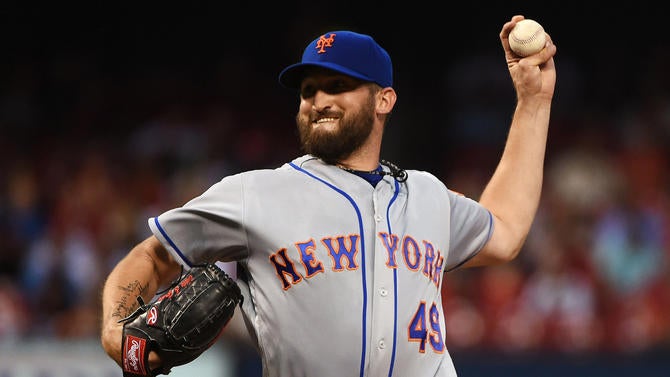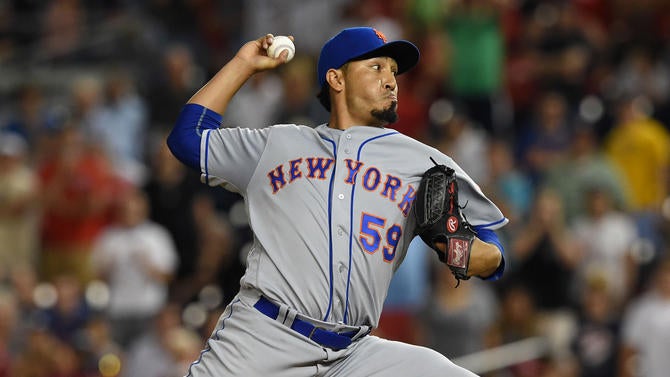In a little more than two weeks, spring training camps across Florida and Arizona will open as pitchers and catchers begin to report. Here is each team's spring reporting schedule.
Over these next few weeks clubs will look to fill out their roster on the cheap with bargain free agents. You can be sure unsigned players are starting to feel the heat. Every year around this time we see remaining free agents take small contracts just to ensure they have a job for the coming season.
This free-agent class wasn't great to start with and now that all the big names are off the board, there aren't any high-end players available. Here is our free-agent tracker. If you're looking for a bench player or bullpen piece, there are some options. Middle-of-the-order hitter or top-of-the-rotation starter? Forget it.
So, now that teams are firmly in bargain-hunting mode, let's look at three unsigned free agents who could prove to be nice little bargains in 2017. These players won't change the balance of power within a division, but they'll provide depth, and depth sure is important.

Chris Coghlan, the 2009 NL Rookie of the Year with the Marlins, has had a roller coaster of a career. He followed up that rookie campaign by hitting .242/.307/.352 (79 OPS+) with -2.0 WAR in over 1,000 plate appearances from 2010-13. Then, in 2014 and 2015, Coghlan rebounded nicely and was a solid utility player with the Cubs.
Coghlan split last season between the Athletics and Cubs -- he was traded to the A's in spring training, then traded back to the Cubs in June -- and was just terrible. He hit .188/.290/.318 (68 OPS+) with -0.5 WAR around rib cage and ankle injuries. The Cubs did carry Coghlan on their postseason roster and he went hitless in seven at-bats, mostly as a pinch-hitter.
The 2016 performance is hideous. No doubt about that. Coghlan has a chance to be a nice low-cost addition right now because, under the hood, there are indications his offense will rebound. Let's look at some numbers, shall we?
| PA | AVG/OBP/SLG | OPS+ | BB% | K% | BABIP | Hard Contact% | |
| 2014-15 | 935 | .265/.346/.447 | 118 | 10.4% | 18.7% | .309 | 31.5% |
| 2016 | 300 | .188/.290/.318 | 68 | 11.7% | 24.3% | .235 | 29.1% |
Last year Coghlan continued to take his walks, and while his hard contact rate dipped, it wasn't a massive drop-off. A 2.4 percent drop qualifies as normal year-to-year fluctuation. And yet, despite that, Coghlan's batting average on balls in play fell 74 points. That is not normal year-to-year fluctuation.
Part of me wonders if Coghlan's increase in strikeout rate was a self-fulfilling prophecy. He struggled and started to press, which led to the increase in strikeouts and continued his season-long slump. It's entirely possible Coghlan is broken beyond repair. But as long as he continues hitting the ball hard, there's reason to believe more balls will fall in for hits and his production will increase.
At this point it's possible if not likely Coghlan will have to settle for a minor-league contract. The Cubs scooped him up on a minor-league deal before 2014 and were rewarded with two seasons of solid production. Coghlan is still only 31, so he's not over the hill, plus he can play every position other than shortstop and catcher. There's room for this versatile left-handed hitter on an NL club's bench.

The Pirates have earned a reputation for fixing pitchers the past few seasons. Guys like Francisco Liriano, A.J. Burnett, Edinson Volquez, J.A. Happ and Ivan Nova all found considerable success in Pittsburgh after struggling elsewhere.
Jonathon Niese, on the other hand, went to the Pirates and got worse. The veteran southpaw threw 364 1/3 innings of 3.75 ERA (96 ERA+) ball for the Mets from 2014-15, which is pretty darn close to league average production. League average isn't sexy, but it is valuable. A healthy league average starter will cost a team upwards of $12 million per year in free agency.
Then, with the Pirates in 2016, Niese had a 4.91 ERA (85 ERA+) in 110 innings. He pitched so poorly he was demoted to the bullpen, and eventually the Pirates traded him back to the Mets, where he allowed 14 runs in 11 innings before undergoing season-ending knee surgery.
That knee injury is why I believe Niese could be a bargain free agent. His season ended on Aug. 23, and after exiting that day's game, Niese told reporters his knee had been bothering him since the middle of June. From NJ.com's Maria Guardado:
"Got to get it fixed," Niese said. "I can't keep going out there like that. There's a lot of pain, it's altering my mechanics, I'm not able to stay behind each pitch. Just not able to locate and I'm really not helping myself out or the team."
Niese said he'd been dealing with the knee issue since the second week of June, when he was a member of the Pittsburgh Pirates, and has already undergone a couple of MRIs and received cortisone shots to manage the injury.
The knee was bothering Niese so much he needed multiple cortisone shots, and yet he continued to pitch for more than two months after the initial injury. That's admirable! I'm sure his teammates appreciated him gutting it out. Then again, it's entirely possible the ongoing knee trouble negatively affected Niese's performance.
On June 7, Niese threw seven shutout innings against the Mets to give him a 3.93 ERA through 12 starts and 71 innings. Not too shabby, eh? From that day forward, Niese pitched to a 7.74 ERA in 50 innings before the knee finally gave out for good. He said his knee first started to act up in the second week of June, and wouldn't you know it, that's when his performance went in the tank.
Now, we don't know exactly when Niese's knee started bothering him and how much it hurt. For all we know the slip in performance and knee issues could be completely coincidental. It's not hard to connect the dots though. Legs injuries are not insignificant for pitchers. It was Niese's left knee, so if his push-off leg was compromised, how could it not impact his performance?
Given the complete lack of quality starters available in free agency, betting on a still only 30-year-old Niese with a healthy knee -- he had his meniscus scoped, so it wasn't a major procedure -- just might be the best option. Reclamation project pitchers are getting one year and $5 million or so these days. When right, Niese is a ground ball heavy southpaw. Lots of teams could use someone like that.

Like Niese, veteran reliever Fernando Salas was a Mets trade deadline pickup, coming over from the Angels. He wasn't so great with Anaheim, throwing 56 1/3 innings of 4.47 ERA (89 ERA+) ball, though with New York he allowed only four runs in 17 1/3 innings while striking out 19 and walking zero.
Salas does three things that just about every manager and team executive can appreciate: he misses bats, limits walks and he can neutralize left-handed batters. He owns a career 24.0 percent strikeout rate -- it was 21.8 percent last season -- and has consistently posted double-digit swing-and-miss rates. The league average was 10.1 percent in 2016.
As for his platoon split, here's what Salas has done against righties and lefties the past three seasons:
| TBF | AVG/OBP/SLG | K% | BB% | HR/9 | |
| vs. RHB | 422 | .236/.289/.438 | 24.9% | 5.9% | 1.24 |
| vs. LHB | 379 | .226/.273/.369 | 24.8% | 5.3% | 1.05 |
Home runs are an issue for Salas and have been for some time. His strikeout and walk rates are superb, and he's actually better against lefties than righties, but the homers stop him from being a great reliever.
The ability to miss bats and avoid a big platoon split are not mutually exclusive. Salas does it by being a rare three-pitch reliever. Most guys focus on their two best pitches when they move to the bullpen, but Salas continues throwing three pitches. That third pitch gives him another option to use against lefties.
Now, throwing three pitches is one thing. Lots of guys can do that. Throwing three effective pitches is another. Look at the swing-and-miss rates on Salas' repertoire over the past two seasons, the Statcast era:
| Salas Whiff% | MLB Average Whiff% | |
| Fastball | 12.7% | 6.9% |
| Curveball | 12.4% | 11.1% |
| Changeup | 14.3% | 14.9% |
For all intents and purposes, Salas gets a league average number of swings and misses with all three pitches, and his fastball is far better than average. He's a workhorse reliever -- Salas has made at least 57 appearances in five of the past six seasons -- with three weapons to go after hitters. That'll play.
The home runs prevent Salas from being a true high-leverage option. He's not someone who really want to run out there with a one-run lead in the eighth or ninth inning, you know? But, in the middle relief role, where he's bridging the gap between the starter and setup man, he could be very useful.
Surely some team will sign the 31-year-old Salas to a relatively small one-year contract at some point soon. And given his three swing-and-miss pitches and ability to retire lefties, there's a good chance that team will be happy with its investment.






















